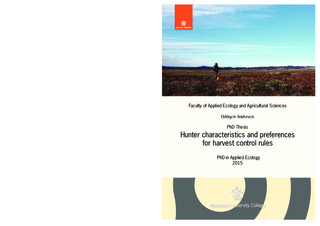Hunter characteristics and preferences for harvest control rules
Doctoral thesis, Peer reviewed
Permanent lenke
http://hdl.handle.net/11250/297983Utgivelsesdato
2015-08-26Metadata
Vis full innførselSammendrag
My thesis is concerned with improving harvest management of ptarmigans and red deer by
increased understanding of hunters’ preferences and by developing hunter typologies. These
species where chosen to illustrate two contrasting management situations, since the number of
harvested willow ptarmigan has been steadily declining, while the red deer harvest is rapidly
increasing. Data is collected by using questionnaires to ptarmigan and red deer hunters. I have
measured factors related to hunting success, preferences for different kinds of harvest
regulations and the effect of environmental attitudes on harvest regulations by using the NEP
scale.
CPUE is commonly used as a descriptor of game abundance. I found no significant
relationship between CPUE and estimated ptarmigan density prior to hunting season. My
results illustrates that using game abundance measured as bird density per km2 alone, not
necessarily are an adequate measure to adjusting harvest rates for ptarmigan. I found hunting
success to be complicated by several intrinsic and extrinsic factors. For example, the number
of ptarmigan observed per day was a better predictor than estimated ptarmigan density on
hunting success.
A quota strategy was the most preferred harvest principle among ptarmigan hunters. Secondly,
hunters preferred a reduction in number of hunters or dividing the season into short periods.
Shortening the length of hunting season was the least preferred principle. Translated into
ptarmigan management, mangers should develop regulations based on annual quotas or quotas
over a longer time span than a daily limit.
Environmental orientation correlated positively with higher acceptance of regulatory
management actions, while socio-demographic variables had limited effect on the relationship
between environmental concern and attitudes toward management actions.
I identified several typologies useful for management purposes. Some characteristics related
to the consumptive orientation, i.e. the importance of meat and the bag size. Also regarding
hunting effort, the hunters grouped into distinct typologies. This eagerness related mostly to
the respondents’ catch-orientation and should be considered in situations where population
reduction/control is an important task. On the other hand, in situations where avoiding
overexploitation is the focus, hunters with strong catch orientation and high effort should be channeled to areas where they pay more for exclusive access and the possibility to bag more
game, in order to facilitate for these hunters. For example, in an area facilitated for “experience
seekers”, it may be wiser to keep a low bag limit, than to reduce number of hunters since they
were least motivated by the importance of bag size. Conversely, the more appreciative- and
less catch-orientated hunters, should be channeled to more crowded areas and stronger harvest
regulations, and to a cheaper price. The latter may be relevant both for ptarmigan hunters
(where the hunters may be satisfied with only a few birds) and deer hunters (for example
hunting access later in the season, or only aiming for antlerless individuals, calves or
yearlings).
I have in my thesis tried to demonstrate the need for increased knowledge about hunters’
preferences for harvest regulations as a contribution to social-ecological systems when
management strategies are developed. Managers should therefore include the hunters’
preferences when implementing different types of harvest regulations. Management of
ptarmigans should be placed somewhere between adaptive management and scenario
planning. The effects of the implemented regulations should also be evaluated at a larger scale,
for example by building management strategy evaluation models. In order to be truly
predictive in any human-altered environment, the system under consideration must include
human users. Therefore, the behavior of individual harvesters and their compliance with
management rules must be included. This requires the integration of ecology with social
sciences into social-ecological systems, in order to improve the predictive power of system
dynamics models. Development of such models is clearly a topic for further research and
advances in this field.
